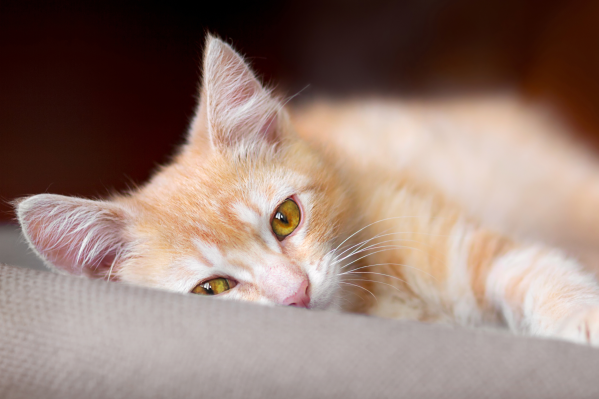Upper respiratory infections (URIs) are sadly an all-too-common ailment that affects our feline friends. The good news is that URIs are treatable, and a condition that you can potentially prevent from getting worse by making sure your cat has the proper care as soon as possible.
Read on to learn about the symptoms your cat gets from URIs, how they get an infection (and how you can reduce their likelihood of contracting it), and what you should do to treat it.
Signs of upper respiratory infections in cats
Common symptoms caused by a URI include:
Sneezing
Nasal discharge
Nasal congestion
Conjunctivitis (redness and swelling of the lining around the eye)
Squinting of the eyes
Mucoid or watery discharge from the eyes
Oral (mouth) ulcers.
Cats with upper respiratory infections may also have additional symptoms such as decreased appetite and lethargy.
How do cats get upper respiratory infections?
Viruses, bacteria, fungi, and protozoa can all cause upper respiratory infections in cats, though viral infection is the most common.
“Most common URIs are viral in origin, with cats getting infected from other cats, either directly via oral-nasal transmission or indirectly, for example when they share the same blankets, toys, and food bowls,” says Dr. Yui Shapard, BVM&S, MRCVS and medical director at Pawp.
Upper respiratory infections can also be fungal in origin, especially in the Midwest region of the United States. They can also be bacterial, though Dr. Shapard explains that bacterial URIs are commonly a secondary infection to a viral URI.
“This is why most common and fairly mild URIs do not require antibiotics,” she explains.
In cats, however, URIs are often caused by the feline herpes virus (aka feline viral rhinotracheitis, or FVR), with up to 97% of cats exposed to the virus in their lifetime. The feline calicivirus is also a common infection cats get that cause URIs with the symptoms described above. One bacteria that causes URIs is Chlamydia felis, which your vet can test for by taking eye swabs, as conjunctivitis is a common symptom for this type of URI.
Most upper respiratory infections in cats take 2-10 days to show symptoms after exposure, with the infection usually lasting for 7-10 days, though some cases may last for up to 3 weeks.
How to treat upper respiratory infections in cats
“Providing cats with aromatic food is one of the most common recommendations we make to pet parents that they can do at home to provide care,” says Dr. Shapard. This is because cats need to be able to smell their food for them to eat. You can also try to gently warm the food in the microwave for a few seconds to release the smell (be careful of heating it too much and burning their mouth).
Nebulization, such as putting your cat in the bathroom with the hot shower running for about 10 minutes, can also help clear up their nasal passages if they are congested.
In some cases, however, further medical intervention may be necessary, especially if the cat’s symptoms don’t improve or worsen even after the treatment described above. If your cat’s appetite decreases or if they become lethargic, you should see a vet right away. Once at the vet’s office, your cat’s veterinarian may give them fluids via IV, antibiotics, or do some tests on your cat to make sure secondary complications like pneumonia haven’t developed.
“In cats, we often prescribe eye drops to decrease the inflammation from the conjunctivitis to provide relief. Cats who have developed ulcers in their mouth from viral URIs would also benefit from medication that reduces pain and inflammation,” says Dr. Shapard.
If your cat has particularly bad sores in their mouth that prevent them from eating, your vet might decide to place a feeding tube through which you can give them prescribed food to make sure they get enough nutrition while they heal.
If you live in the Midwest and you think your cat might have a URI, it’s best to make a vet appointment sooner rather than later, as fungal URIs—which are common in this region—can become much more serious and should have veterinary intervention in the early stages of the infection.
How to prevent upper respiratory infections in cats
The good news is that there is a vaccine for FVR and the feline calicivirus that will reduce the risk of your feline friend getting an infection, or if they do, make their symptoms significantly less severe. Many cats, however—especially those who came from a cattery or shelter where a large number of them are grouped together—will likely already have been exposed to the virus. Even if they’ve already been infected, Dr. Shapard strongly recommends that pet parents get the FVRCP vaccine, especially if their feline friend goes outdoors or if a new cat will be entering the household.
You can also reduce the risk of your cat getting an upper respiratory infection by keeping them indoors, by not boarding them at a crowded facility, and by keeping them away from any cat (including another cat in the house) who has symptoms. Even if your cat does get a URI, however, the good news is that, with proper treatment, they will soon be feeling better and back to their old self.
If you suspect your cat has an upper respiratory infection or have questions about next steps, reach out to the Pros at Pawp. We're here to help 24/7.

Reviewed and fact-checked by
Dr. Mari, DVM at Pawp
